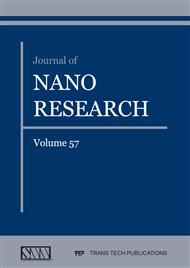[1]
S. Gurunathan, J. Han, J. H. Park and J-H. Kim, A green chemistry approach for synthesizing biocompatible gold nanoparticles, Nanoscale Res. Lett. 9 (2014) 248.
DOI: 10.1186/1556-276x-9-248
Google Scholar
[2]
X. F. Zhang, Z-G. Liu, W. Shen and S. Gurunathan, Silver Nanoparticles: Synthesis, Characterization, Properties, Applications, and Therapeutic Approaches, Int. J. Mol. Sci. 17, 9 (2016) 1534.
DOI: 10.3390/ijms17091534
Google Scholar
[3]
J. S. Kang H. S. Kim, J. Ryu, H. Thomas Hahn, S. Jang, J. W. Joung, Inkjet printed electronics using copper nanoparticle ink, J. Mater. Sci. Mater. Electron. 21, 11 (2010) 1213–1220.
DOI: 10.1007/s10854-009-0049-3
Google Scholar
[4]
A. Atwater and A. Polman, Plasmonics for improved photovoltaic devices, Nat. Mater. 9 (2010) 205–213.
DOI: 10.1038/nmat2629
Google Scholar
[5]
K. R. Catchpole and A. Polman, Design principles for particle plasmon enhanced solar cells, Appl. Phys. Lett. 93 (2008) 191113.
DOI: 10.1063/1.3021072
Google Scholar
[6]
K. R. Catchpole and A. Polman, Plasmonic solar cells, Opt. Express 16 (2008) 21793–21800.
DOI: 10.1364/oe.16.021793
Google Scholar
[7]
R. Lu, L. Xu, Z. Ge, R. Li, J. Xu, L. Yu and K. Chen, Improved Efficiency of Silicon Nanoholes/Gold Nanoparticles/Organic Hybrid Solar Cells via Localized Surface Plasmon Resonance, Nanoscale Res. Lett. 11, 160 (2016).
DOI: 10.1186/s11671-016-1374-0
Google Scholar
[8]
P. H. Wang, M. Millard and A. G. Brolo, Optimizing Plasmonic Silicon Photovoltaics with Ag and Au Nanoparticle Mixtures, J. Phys. Chem. C 118, 11 (2014) 5889–5895.
DOI: 10.1021/jp409351v
Google Scholar
[9]
S. Carretero-Palacios, A. Jiménez-Solano and H. Míguez, Plasmonic Nanoparticles as Light-Harvesting Enhancers in Perovskite Solar Cells: A User's Guide, ACS Energy Lett. 1, 1 (2016 Jul 8) 323–331.
DOI: 10.1021/acsenergylett.6b00138
Google Scholar
[10]
A. Kossoy, V. Merk, D. Simakov, K. Leosson, S. Kéna-Cohen and S. A. Maier, Optical and Structural Properties of Ultra-thin Gold Films, Adv. Opt. Mater. 3 (2015) 71–77.
DOI: 10.1002/adom.201400345
Google Scholar
[11]
M. C. Daniel, D. Astruc, Gold nanoparticles: assembly, supramolecular chemistry, quantum-size-related properties, and applications toward biology, catalysis, and nanotechnology, Chem Rev. 104 (2004) 293.
DOI: 10.1021/cr030698+
Google Scholar
[12]
H. Jans, K. Jans, L. Lagae, G. Borghs, G. Maes, Q. Huo, Poly(acrylic acid)-stabilized colloidal gold nanoparticles: synthesis and properties, Nanotechnology 21 (2010) 455702.
DOI: 10.1088/0957-4484/21/45/455702
Google Scholar
[13]
C. Li, D. Li, G. Wan, J. Xu and W. Hou, Facile synthesis of concentrated gold nanoparticles with low size-distribution in water: temperature and pH controls, Nanoscale Res. Lett. 6 (2011) 440.
DOI: 10.1186/1556-276x-6-440
Google Scholar
[14]
M. T. Swihart, Vapor Phase Synthesis of Nanoparticles, Curr. Opin. Colloid Interface Sci. 8 (2003) 127–133.
Google Scholar
[15]
Suryanarayana and Prabhu, Nanostructured Materials: Processing, Properties, and Applications, Second Ed., William Andrew Inc., 2007, 51-80.
Google Scholar
[16]
R. Fernando, F. Semendy and P. Wijewarnasuriya, Altering Plasmonic Nanoparticle Size Through Thermal Annealing for Improved Photovoltaic Devices, Technical Report, ARL - TR-5895, January (2012).
Google Scholar
[17]
M. Y. Li, E. S. Kim and J. Lee, Annealing temperature effect on self-assembled Au droplets on Si (111), Nanoscale Res. Lett. 8, 1 (2013) 525.
DOI: 10.1186/1556-276x-8-525
Google Scholar
[18]
A. Plaud, A. Sarrazin, J. Béal, J. Proust, P. Royer, J.L. Bijeon, J. Plain, P.M. Adam and T. Maurer, Copolymer template control of gold nanoparticle synthesis via thermal annealing, J. Nanoparticle Res. 15 (2013) 2109.
DOI: 10.1007/s11051-013-2109-0
Google Scholar
[19]
B. J. Y. Tan, C. H. Sow, T.S. Koh, K.C. Chin, A.T.S. Wee and C.K. Ong, Fabrication of Size-Tunable Gold Nanoparticles Array with Nanosphere Lithography, Reactive Ion Etching, and Thermal Annealing, J. Phys. Chem. B 109 (2005) 22.
DOI: 10.1021/jp045172n
Google Scholar
[20]
L. Zhao, C. Zhou, H. Li, H. Diao and W. Wang, Characterization on the Passivation Stability of HF Aqueous Solution Treated Silicon Surfaces for HIT Solar Cell Application by the Effective Minority Carrier Lifetime Measurement, Chin. J. Phys. 48, 3 (2010) 392-399.
Google Scholar
[21]
V. A. Volodin and D. I. Koshelev, Quantitative analysis of hydrogen in amorphous silicon using Raman scattering spectroscopy, J. Raman Spectrosc. 44 (2013) 1760–1764.
DOI: 10.1002/jrs.4408
Google Scholar
[22]
Milton Ohring, Materials Science of Thin Films, Second Ed., ISBN: 978-0-12-524975-1, Elsevier Inc. (2002).
Google Scholar
[23]
Carlson O. N., The N-Si (Nitrogen-Silicon) System, Bull. Alloy Phase Diagr. 11, 6 (1990) 569.
Google Scholar
[24]
Y. Suizu, Rapid thermal annealing for semiconductor substrate by using incoherent light, United States Patent, Patent Number 5279973, (1994).
Google Scholar
[25]
T. Ito, S. Hijiya, T. Nozaki, H. Arakawa, M. Shinoda and Y. Fukukawa, Influence of Preoxidation Annealing on Stacking Fault Generation Due to Mechanical Damage on Silicon Surfaces, J. Electrochem. Soc. 125 (1978) 448.
DOI: 10.1149/1.2131471
Google Scholar
[26]
C. Y. Wu and C. W. King, Growth-kinetics of silicon thermal nitridation, J. Electrochem. Soc. 129, 7 (1982) 1559-1563.
DOI: 10.1149/1.2124207
Google Scholar
[27]
D. Henscheid, M. N.Kozicki, G. W. Sheets, M. Mughal, I. Zwiebel, R. J. Graham, Rapid thermal nitridation of thin SiO2 films, J. Electron. Mater. 18, 2 (1989) 99-104.
DOI: 10.1007/bf02657393
Google Scholar
[28]
J. Dabrowski, H. J. Mussig, Silicon Surface and Formation of Interfaces: Basic Science in the Industrial World, World Scientific Publishing Co. Pte. Ltd. (2000).
Google Scholar
[29]
Z. Ma, X. Liao, G. Kong, J. Chu, Absorption spectra of nanocrystalline silicon embedded in SiO2 matrix, Appl. Phys. Lett. 75 (1999) 1857.
DOI: 10.1063/1.124851
Google Scholar
[30]
N.M. Park, S.H. Kim, G. Y. Sung, S.J. Park, Growth and Size Control of Amorphous Silicon Quantum Dots Using SiH4/N2 Plasma, Chem. Vap. Deposition 8, 6 (2002) 254-256.
DOI: 10.1002/1521-3862(20021203)8:6<254::aid-cvde254>3.0.co;2-s
Google Scholar
[31]
V. Volodin, M.D. Efremov, V.A. Gritsenko, S.A. Kochubei, Raman study of silicon nanocrystals formed in SiNx films by excimer laser or thermal annealing, Appl. Phys. Lett. 73 (1998) 1212-1214.
DOI: 10.1063/1.122130
Google Scholar
[32]
G. Gerlach, W. Dötzel and R. Pething, Introduction to Microsystem Technology: A Guide for Students, Wiley Microsystem and Nanotechnology, Wiley Publishing (2008).
Google Scholar


